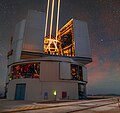File:Creator of stars (potw2147a).tiff

Original file (6,627 × 6,216 pixels, file size: 235.77 MB, MIME type: image/tiff)
Captions
Captions
Summary[edit]
| Warning | The original file is very high-resolution. It might not load properly or could cause your browser to freeze when opened at full size. |
|---|
| DescriptionCreator of stars (potw2147a).tiff |
English: Powerful lasers leave the dome of one of the four Unit Telescopes of ESO’s Very Large Telescope (VLT) at Paranal Observatory in Chile. The beams reach a layer of the atmosphere about 90 kilometres above the ground, very rich with atoms of sodium. The lasers make the sodium shine, creating artificial stars in the sky. But why?Earth’s atmosphere distorts light reaching us from cosmic objects, decreasing the sharpness of astronomical observations. This is the same reason why stars seen from Earth appear to “twinkle”. To correct observations for this effect, astronomers have developed a technology known as adaptive optics, where a flexible mirror is deformed hundreds of times per second to counteract atmospheric turbulence. However, to calculate the necessary corrections, adaptive optics need reference stars close to the observed object. Such stars are not always ideally placed, though, which made astronomers come up with the idea of using lasers to have artificial stars optimally located in the sky any time they are needed.Fun fact: those sodium atoms are left over from meteoroids which terminated their journey across the Solar System by entering and burning up in the Earth’s atmosphere. So, in a way, when we excite those sodium atoms with lasers we are using space matter to help us observe space! |
||
| Date | 22 November 2021 (upload date) | ||
| Source |
|
||
| Author | ESO/M. Zamani | ||
| Other versions |
|
Licensing[edit]
 |
This media was created by the European Southern Observatory (ESO).
Their website states: "Unless specifically noted, the images, videos, and music distributed on the public ESO website, along with the texts of press releases, announcements, pictures of the week, blog posts and captions, are licensed under a Creative Commons Attribution 4.0 International License, and may on a non-exclusive basis be reproduced without fee provided the credit is clear and visible." To the uploader: You must provide a link (URL) to the original file and the authorship information if available. |
This file is licensed under the Creative Commons Attribution 4.0 International license.
| |
File history
Click on a date/time to view the file as it appeared at that time.
| Date/Time | Thumbnail | Dimensions | User | Comment | |
|---|---|---|---|---|---|
| current | 22:48, 20 January 2024 |  | 6,627 × 6,216 (235.77 MB) | OptimusPrimeBot (talk | contribs) | #Spacemedia - Upload of https://cdn.eso.org/images/original/potw2147a.tif via Commons:Spacemedia |
You cannot overwrite this file.
File usage on Commons
The following page uses this file:
Metadata
This file contains additional information such as Exif metadata which may have been added by the digital camera, scanner, or software program used to create or digitize it. If the file has been modified from its original state, some details such as the timestamp may not fully reflect those of the original file. The timestamp is only as accurate as the clock in the camera, and it may be completely wrong.
| Camera manufacturer | Canon |
|---|---|
| Camera model | Canon EOS 5D Mark IV |
| Exposure time | 25/1 sec (25) |
| F-number | f/1.4 |
| ISO speed rating | 6,400 |
| Date and time of data generation | 07:04, 5 July 2019 |
| Lens focal length | 35 mm |
| Width | 6,627 px |
| Height | 6,216 px |
| Bits per component |
|
| Compression scheme | Uncompressed |
| Pixel composition | RGB |
| Image data location | 57,620 |
| Orientation | Normal |
| Number of components | 3 |
| Number of rows per strip | 6,216 |
| Bytes per compressed strip | 247,160,592 |
| Horizontal resolution | 300 dpi |
| Vertical resolution | 300 dpi |
| Data arrangement | chunky format |
| Software used | Adobe Photoshop CC 2019 (Windows) |
| File change date and time | 22:11, 3 September 2019 |
| Exposure Program | Manual |
| Exif version | 2.31 |
| Date and time of digitizing | 07:04, 5 July 2019 |
| APEX shutter speed | −4.643856 |
| APEX aperture | 0.970854 |
| APEX exposure bias | 0 |
| Maximum land aperture | 1 APEX (f/1.41) |
| Metering mode | Partial |
| Flash | Flash did not fire, compulsory flash suppression |
| DateTimeOriginal subseconds | 001 |
| Color space | Uncalibrated |
| Focal plane X resolution | 1,866.6666564941 |
| Focal plane Y resolution | 1,866.6666564941 |
| Focal plane resolution unit | 3 |
| Custom image processing | Normal process |
| Exposure mode | Manual exposure |
| White balance | Auto white balance |
| Scene capture type | Standard |
